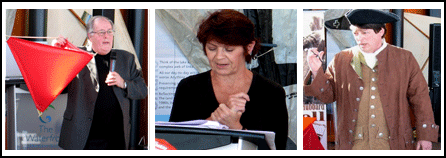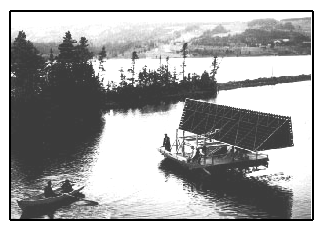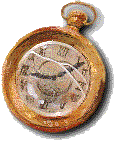Entries in Historical Kiting Events (6)
First Kite History Symposium Held In Burlington, Ontario.
On February 6, 2010 a group of interested kite enthusiasts gathered at Discovery Landing, on the Lake Ontario shoreline in Burlington, Ontario, to immerse themselves in day dedicated to the exploration of kite history. This was the first ever Kite History Symposium held in eastern North America.
The event was sponsored and organized by the Canadian Kite Museum under the direction of George Paisiovich, Museum Founder and Director.

The program for the day featured:
- a two hour informal morning gathering of the registered kiters examining historic kite artefacts, photographs and print materials;
- a welcome to the Kite History Symposium by George Paisiovich in which he outlined his goal of providing a periodic forum for the discussion and advancement of knowledge of kite history;
- a one hour presentation by Bob White of Port Colborne, ON about the kites of Dr. Alexander Graham Bell. This preliminary report on research in progress brought participants up to date on the work being done to carefully detail the step by step progress made by Dr. Bell on his path to understand the principles of flight and to get a person into the air.
- a presentation by Meg Albers of Buffalo, NY on the kite exploits of Homan Walsh whose kite helped to build a bridge across the Niagara River in 1848. Meg also revealed some documents she has received that prove the use of kites during the American Civil War. She continues her research into kites in the Civil War era.
- a two hour presentation by Thom Shanken of Waterloo, NY about his research into the world's oldest kite currently located at the Drachen Foundation in Seattle, WA. Thom Shanken, an expert in 16th century kites, was invited by the Drachen Foundation to examine the kite and make a detailed analysis of this amazing historical find. Thom presented slides and an interesting description of his work with the kite. Following this, a replica of the kite was constructed by the participants. The replica is detailed in the slide show below. The replica is now part of the collection of the Canadian Kite History Museum.

At the end of the day, the participants gathered for an informal evening meal and conversation about the events of the day.
A terrific slide show of the Kite History Symposium was prepared by Ted Shaw of the Great Lakes Kitefliers in Western New York state. My appreciation is extended to Ted for allowing me to share his photos of the event here.
The next Kite History Symposium sponsored by the Canadian Kite Museum will be held in October 2010. As details are announced I will provide a link to the information here.
Appreciation is extended to George Paisiovich for his outstanding work in support of the preservation of kite history and efforts to foster and disseminate knowledge of current kite history research work that is underway.
Updated Time Lines of Kite History
 The Time Lines of Kite History, an often visited feature of the Best-Breezes web site, were updated to Version 2.1 after extensive review of the original time line research. The review and update took a period of six months as new source material was reviewed and additional conversations were held with kite history experts.
The Time Lines of Kite History, an often visited feature of the Best-Breezes web site, were updated to Version 2.1 after extensive review of the original time line research. The review and update took a period of six months as new source material was reviewed and additional conversations were held with kite history experts.
Although Version 2.1 is as up-to-date as possible, it is anticipated that more revisions and updates will be made in the months and years ahead.
I welcome conversation and dialogue on this time line and hope that you will share any possible findings of yours which may lead to new inclusions or corrections on those items that, although carefully researched, may still need some detailed fine tuning.
Throughout time, the kite has been an object of great fascination and value to human kind. The Time Lines of Kite History presented here are intended to help preserve this history for those who are interested in all aspects and applications of kites over the years.
Bell's Tetrahedral Kite - Centennial Celebrations
 One hundred years ago, on December 6, 2007, Alexander Graham Bell launched his largest tetrahedral kite, the Cygnet II, over the waters of Bras d'Or lake in Cape Breton, Nova Scotia. Towed behind a steam powered boat and carrying Lieut. Thomas Selfridge as passenger and to some degree pilot, the Cygnet was a milestone in the history of the development of flight and one of the most significant events in Canadian kite history.
One hundred years ago, on December 6, 2007, Alexander Graham Bell launched his largest tetrahedral kite, the Cygnet II, over the waters of Bras d'Or lake in Cape Breton, Nova Scotia. Towed behind a steam powered boat and carrying Lieut. Thomas Selfridge as passenger and to some degree pilot, the Cygnet was a milestone in the history of the development of flight and one of the most significant events in Canadian kite history.
A great deal of attention is being paid to the tetrahedral kites of Dr. Bell during this centennial celebration year marking the historic flight of the huge Cygnet. It certainly is a time to pause and remember the amazing ingenuity of the era as humans searched for the best ways to lift people into the sky in a safe and controlled manner.
Bell's intention was to use the inherently strong tetrahedron as a building block for an 'aerodrome' (aircraft) that would eventually be powered by a gasoline engine and achieve independent flight under the control of a pilot.
The Halifax Chronicle Herald ran a feature story on the work of Bell's Aerial Experiment Association, a group of five engineer-scientist fellows. The group was funded with a $30,000 investment provided by Mabel Bell, Dr. Bell's wife, who acted as the group's Secretary-Treasurer.
Uplifting dream was born century ago
Within 18 months, Bell-led group had Silver Dart in Baddeck sky
By TERA CAMUS Cape Breton BureauThe ChronicleHerald.ca October 1, 2007
BADDECK — It was 100 years ago today when it all began.
High on the hill overlooking Baddeck Bay, Alexander Graham Bell invited four men to his estate to begin working on a dream that would literally take flight 18 months later, in 1909.
Backed with $30,000 from Mr. Bell’s wealthy socialite wife Mabel, five creative minds forged a partnership known as the Aerial Experiment Association after the famous, aging inventor convinced them they could take flight in an aircraft after experimenting with large kites on and over his Baddeck estate.
"It’s amazing to think that for thousands and thousands of years, we couldn’t fly and within 18 months, bang, we’re flying among the stars," Mr. Bell’s great-grandson, Hugh Bell Muller, told The Chronicle Herald inside the Kite House where the five men constructed the aircraft.
Mr. Muller and his wife still walk on the original floorboards of that former barn, now renovated into a comfortable home, where Alec Bell, as he was known locally, worked with British immigrant Douglas McCurdy, a resident of Baddeck, and Toronto’s Casey Baldwin, both expert engineers. He also invited United States Lt. Thomas Selfridge and Glenn Curtiss, a New Yorker who built engines.
All five men lived in "the big house," better known as Beinn Bhreagh, which now is only open in summers for Mr. Bell’s direct descendants.
"In Bell’s time, he knew all the scientists," Mr. Muller said. "As a kid, he dreamed about flying while watching the birds."
The Wright Brothers, who had proved an aircraft could lift off using a catapult method, were busy in the United States trying to understand how to maintain flight.
"Bell was concerned with two things, the first was safety and the other was stability of controls to maintain a flight," Mr. Muller said. "Ms. Bell told him: ‘The five of you get an airplane in that air’ and it took 18 months to get the Silver Dart."
The first aircraft built in the Kite House in 1907 was the Cygnet, but it had no engine. It carried Selfridge for seven minutes and 51 metres and "flew beautifully" before it crashed into the water below Mr. Bell’s estate.
Moving on from the Cygnet, Bell and the five members of the AEA built four powered airplanes that were stable and reliable in flight. The culminating aircraft was the famous "Silver Dart" which was the first airplane to fly in the British Commonwealth of Nations when it lifted off the frozen waters of Bras d'Or Lake on February 23, 1909.
During this centennial celebration year of the massive Cygnet kite, a special commemorative kite fly was organized by the Canadian Kite Federation/Federation Canadienne du Cerf-Volant amd the Drachen Foundation of Seattle WA. The event was held on the Bell estate at Beinn Bhreagh overlooking Bras d'Or Lake in Baddeck, Nova Scotia on August 21, 2007.
Gary Mark of CKF/FCCV and Scott Skinner of the Drachen Foundation were instrumental in putting together the kite fly tribute to Bell's work with the Cygnet kite. More information can be found in an excerpt from the web site of the Drachen Foundation. A terrific video of interviews with Gary Mark, principal organizer of the event, and Hugh Muller, great-grandson of Alexander Bell is found on a special video clip at YouTube. Another interesting video clip is the CBC-TV Newsworld live broadcast of the event, also at YouTube.
In the autumn of 2004, CBC ran a television series entitled: The Greatest Canadian. Alexander Graham Bell was one of the featured candidates for the title of the greatest Canadian. I had the privilege of working on the production of that television show along with my good friend Gary Mark. To read about that story you can see an earlier posting in the Best-Breezes blog that detailed Bell's tetrahedral kites and see how a kite was included in the video taping for the show.
In the web site section of Best-Breezes, you can find more detailed information on Bell's Cygnet kite, the aerodromes of the Aerial Experiment Association, and a variety of other references on Bell's work with kites and aircraft. Be sure to check out the article entitled: Alexander Graham Bell: After the Telephone - Tetrahedral Kites, Airplanes and Hydrofoils.
One hundred years later the memory of Alexander Graham Bell's giant tetrahedral kites still lifts the imagination and makes the spirit soar!
The Time it Took! A Timeline of Kite History
 Time, it has been said, marches resolutely on and leaves a record of what has gone before if we are careful to observe.
Time, it has been said, marches resolutely on and leaves a record of what has gone before if we are careful to observe.
There are so many historical events over the course of time. The most recent events and happenings are well recorded and documented but can still be open to varying interpretation. The more distant events are harder to trace and often do not have many validating or corroborating sources of information. So it is with the history of the earth, of mankind, of cultures and nations, and of devices and inventions.
Several years ago, sixteen to be exact, I set out to puzzle out for myself a credible timeline of kite history. The purpose in my mind was simple: order the events and chronicle the people who had contributed to the development of the kite and used it in innovative and interesting ways. A simple task, I was sure.
Not so! Here I am sixteen years later publishing for the first time my efforts at recording a brief, and hopefully useful, chronology of the kite. I have postponed the publication of any of the timelines on this web site many times. I did this because I continued to find conflicting evidence about the order and timing of events. Revision, checking more sources, update and more revision became an ongoing state of affairs.
I believe that the timelines published here today are very accurate, but they are not infallible. As with any historical effort covering a broad scope there is room for error even with the most thorough checking of facts having been carried out.
I know that these timelines will need to be revised again and again as new information is brought forward and as conflicting evidence challenges details or dates.
I have published the timelines at this juncture because I believe in their accuracy. I know that the scrutiny of kiters and people with a deep interest in things historical will undoubtedly lead to challenges and the correction of possible errors. I welcome your input, your questions, your dialogue and your sharing of factual evidence. Only through such cooperative effort can a properly validated timeline of kite history be available for use by students in schools and for reference by kiters who would like to know more about the development of this amazing device, the kite.
To begin your journey through time and experience the chronicle of the kite, I invite you to visit the Best-Breezes Timeline of Kite History.
Please contact me if you wish more information, have questions or can suggest some sources or evidence to improve the timeline.
Bob White - Hifliercanada - October 30, 2006
_______________________________________
Captain Jean-Luc Picard:
"Time is a companion that goes with us on a journey. It reminds us to cherish each moment, because it will never come again. What we leave behind is not as important as how we have lived."
played by Patrick Stewart, from the film "Star Trek: Generations"
Scott Haefner and the Drachen Foundation Recreate Lawrence's Post Earthquake Aerial Photo Scenario
Last week, on the 100th anniversary of the San Francisco earthquake of 1906, Best-Breezes brought you a blog entry on Goerge Lawrence and his amazing photos of the devastation of that quake by way of his kite aerial camera. Also at that time, we noted that Scott Haefner, a noted Kite Aerial Photographer, was working with the Drachen Foundation of Seattle WA to recreate the historic photos with modern KAP equipment.
Well, today the current photos by Haefner are available on the Drachen Foundation's website. What a spectacular view and great project. Typical of Scott Skinner, Ali Fujino and the Drachen Foundation this project is first class and adds greatly to the dissemination of knowledge about kites and their role in history. The complete story and photos by Scott taken from his aerial rig are amazing. Well done everyone!
For a complete press release and description of the event visit the PR Web (Press Release Newswire) site to see all the details as well as information on George Lawrence, Scott Haefner, and the Drachen Foundation.





